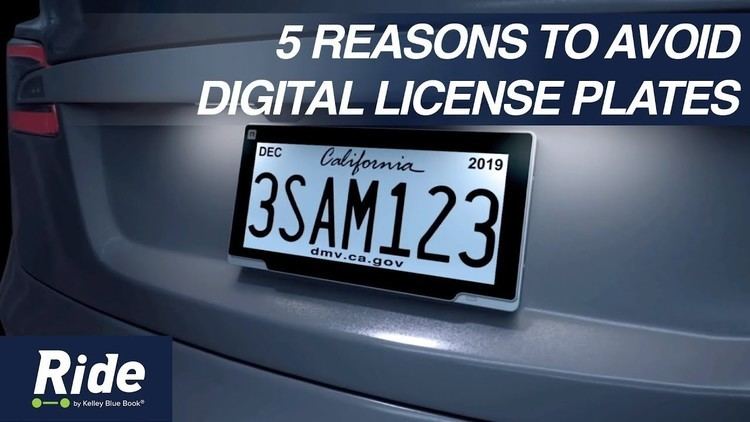Similar Vanity plate, FE Schrift, Pay by plate parking | ||

An electronic license plate (also referred to as a digital display license plate) is an identification sign mounted on vehicles that emits wireless signals used for tracking and digital monitoring services. Various patents that include advanced features have been published with the intent of replacing traditional metal license plates. The electronic license plate has a complex design that works directly with the vehicle's computer system and can communicate with outside sources that can remotely access it for the regulation of vehicle use.
Contents
Concept
Inventor Dean L. Naddeo published a patent on June 11, 2002, for the improvement of existing license plates. Naddeo's intention was to create a further use of traditional license plates, and potentially maximize its ability. It can serve a greater use by lowering crime, lowering cost and replacing other forms of identification (such as algorithms) by introducing electronic monitoring.
Features
The electronic license plate has very advanced features compared to the traditional license plate. It functions as more than just a identification sign; it can also give information, be used for pre-paid services, and provide a more beneficial form of security.
Information
Information can be looked up only for legal purposes due to privacy regulations. Very specific information can be acquired from a running vehicle remotely, and can be as specific as the vehicle's speed, time and position. Such information is useful for patrolling highways, to reduce speed violations and increase safety. Simpler information such as car identification number, date of expired registration, proof of insurance and legal status are displayed digitally on the screen.
Prepaid services
Services can be prepaid digitally and updated automatically, which saves time. Vehicle registration is the primary service that can be renewed instantly. Parking permits can also be associated with the license plates, and can be monitored remotely. Toll fees can also be prepaid because the license plate can communicate with the global positioning system (GPS) to set up routes, calculate cost of travel, and send signal for payment as it passes through a toll booth.
Security
Security can be improved by the electronic license plate because it can reduce the chances of a criminal fleeing a scene if a vehicle is in an accident or associated with a crime. In these situations, the plate would emit a signal of collision or crime, directly identifying the vehicle's involvement. If not identified at the scene, the license plate holds it in memory and displays a digital alert. Surveillance also benefits from this advanced technology because the electronic license plate emits a clear signal captured by surveillance equipment instead of a distorted image.
Design
The electronic license plate is a 12-by-16 inch digital display with a rectangular housing, similar to the traditional license plate. It is powered directly from the vehicle's power system and can communicate with its computer. The internal components fit inside the housing and are set together in a circuits critical for the functions of this technology.
Internal
External
Privacy
Privacy is a major factor in why electronic license plates are not out to the public. Since hacking and identity fraud is an issue, this has led in-depth testing and development. For consumer privacy, information will only be sent out when the vehicle is involved with any violations or illegal activities. It is now made with tamper-resistant hardware to prevent information from being acquired from unauthorized parties. The vehicle can be disabled automatically if any tampering is sensed; for example, the removal of an electronic plate will disable a vehicle making it difficult for identity theft. Tampering to avoid payments, violations or crime will alarm law enforcement in order to lower risk for both sides the consumer and third parties.
Future
Two states in the US are reaching out for an alternative to metal license plates. The governor of California has set up California's Electronic License Plate Pilot Program, which will test alternatives. In 2017, California expects to issue electronic license plates to a limited number of volunteers to test this new technology. The main reason for California's interest for an alternative is to reduce taxpayers' expense. Digital plates are projected to reduce $20 million spent by the Department of Motor Vehicles. South Carolina has also shown interest into alternatives, and has also set up pilot programs.
